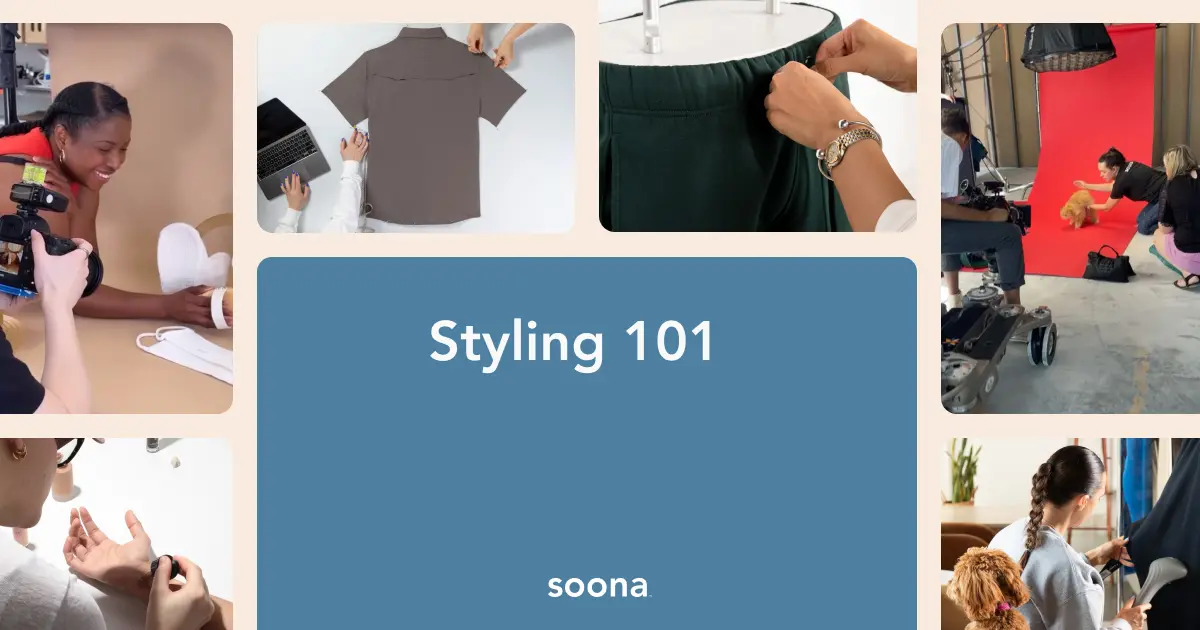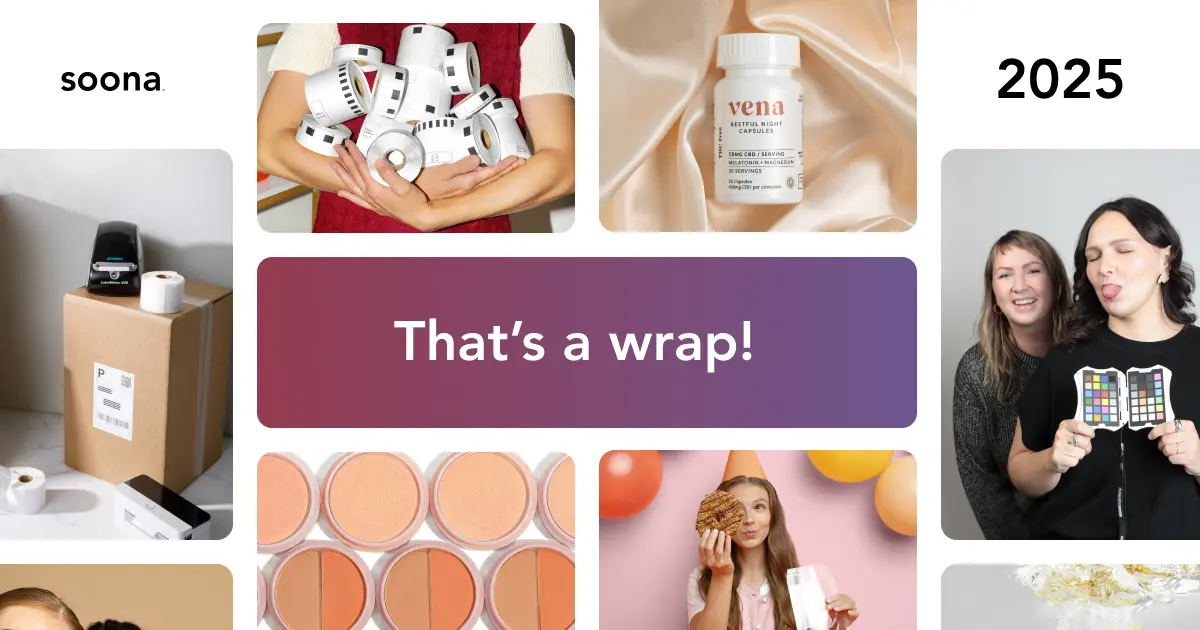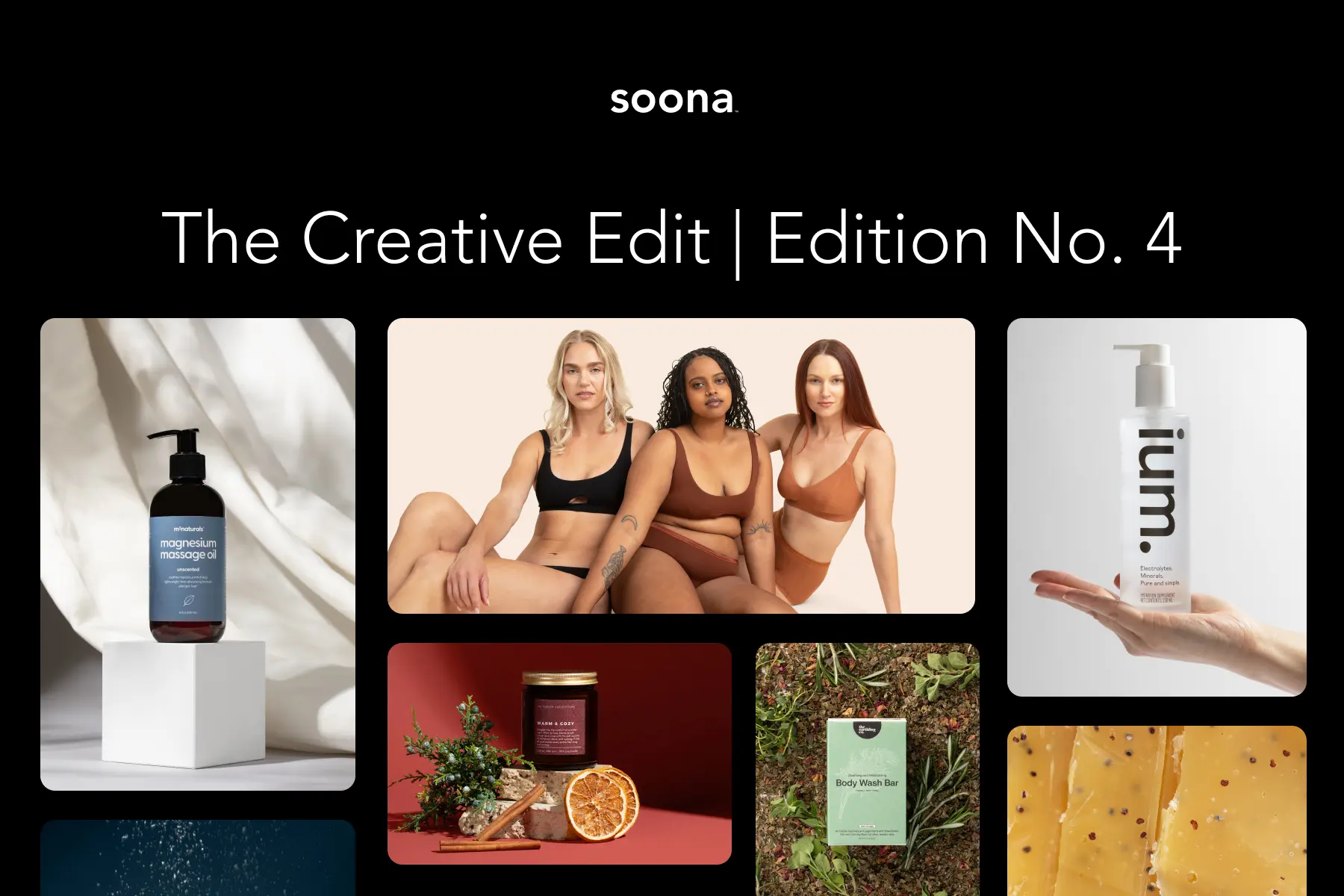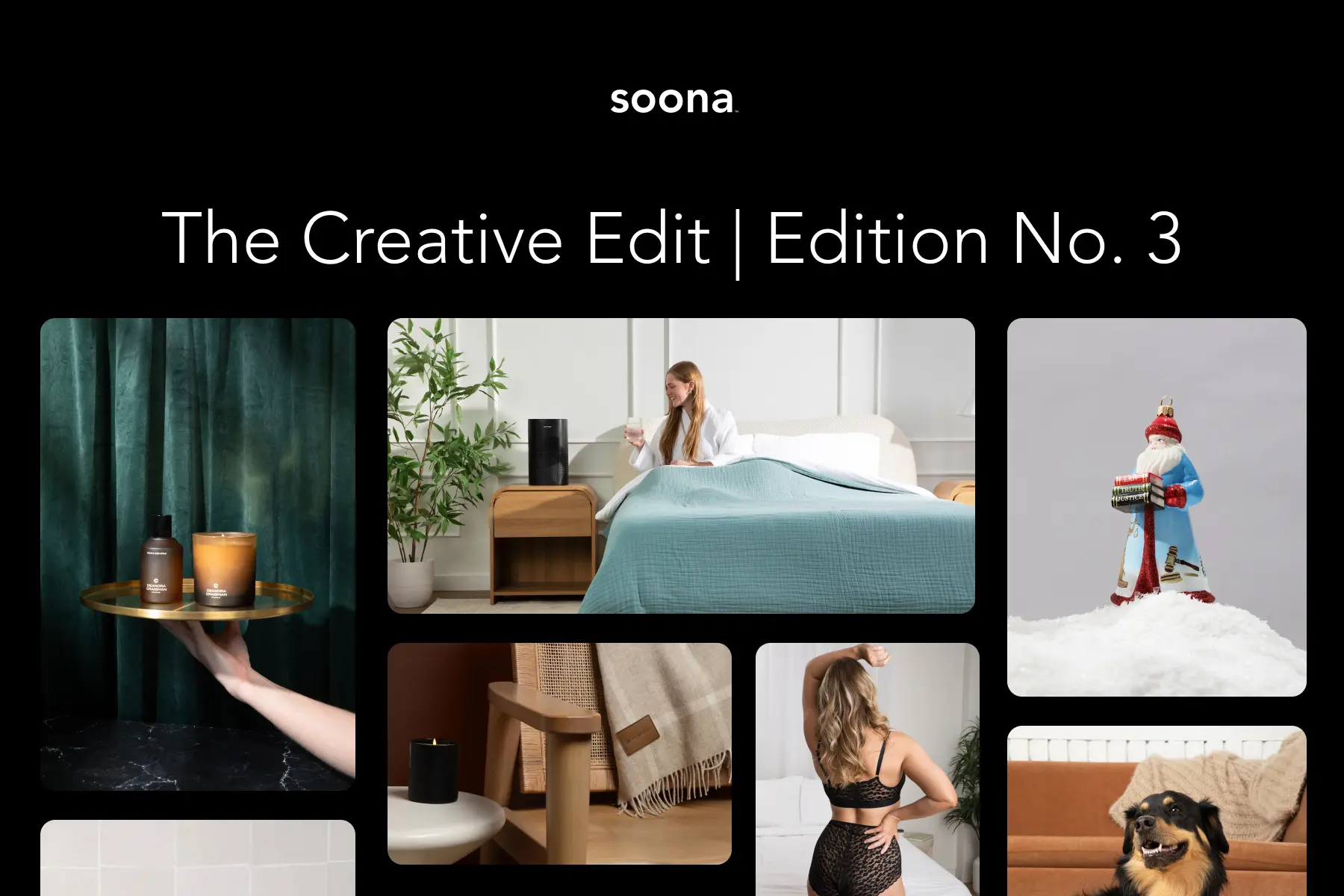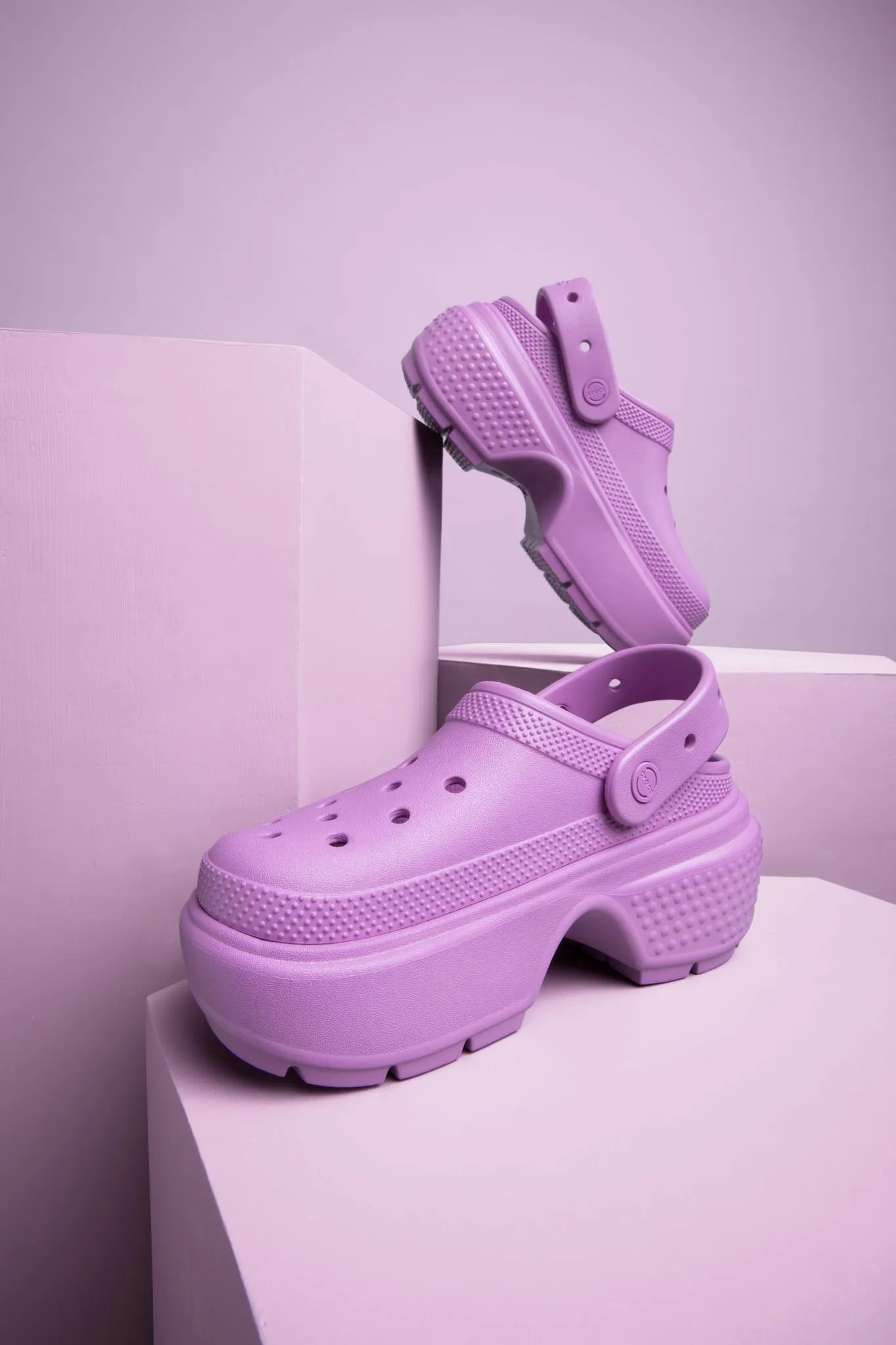Model photography brings something to the table that flat lays and mannequin shots just don’t seem to capture—life, jazz, movement. Sometimes that’s just what your product pages need to drive conversions.
But you can’t just use any old model photos—you gotta capture those high-quality gems. We’re not talking about hiring high-fashion models, but you’ll need to invest a little bit of time and effort into the process to set your shots up for success.
Understanding how to prepare for and nail your ecommerce model photography can feel a bit overwhelming. So, here’s the 411 on how you can use ecommerce on-model photography to drive sales for your online store.
Book a model in just a click! Only pay a one-time fee and use your content forever >
Why you need a model for ecommerce photography
Flat lays, mannequins, and models each have their moment. Knowing when to use each type of product photography is key to engaging your customers with stunning visuals and driving sales.
Mannequin and flat lay shots are effective when you want the products to speak for themselves on your ecommerce website. These two types of product photography minimize visual distractions and let your customers focus on the product.

But many times those images don’t tell the whole story. Leaving part of the product story out can mean falling flat when it comes to sales. Customers want to understand your product. What is its history? What does its journey look like? Flat lays and mannequin shots might leave out critical details that can influence customers to move past any barriers to purchase.
Sure, you can spice your flat lay up with some creative props. But nothing compares to lifestyle images created with model photography. They give your products an enviable quality. Customers can imagine themselves (and what their lives would be like) when they commit to the purchase.
Professional models know just how to showcase your products. Sometimes flat lays can look a little, well, flat. They lack dynamic movement. Don’t misunderstand, there’s a time and place for flat lays. But models can do that flowy garment more justice than a flat lay or mannequin can.
{{studio-ad}}
Types of models in product content
While you might think of the traditional high-fashion model when you think of “models,” there are actually plenty of creative ways to showcase people—and pets!—in your visual product content.

Full body
A full body model shot features all or most of the model in the content. This could be everything from their feet to the top of their head. Full body models increase your customers’ purchase confidence by showing a real person falling in love with your brand.

Full body models are required for:
- Showing a friendly face with your product
- Featuring body parts beyond the hand and forearm
- Consuming food or beverage products
- Wearing clothing, accessories, and shoes
- Video demonstration
Full body models start at $159/hour with soona >
Hand
Shots featuring hand models are—you guessed it—images that only show the person’s hand and perhaps wrist and arm as well. You can use hand models to demonstrate the size, scale, and features of your product. Hand models add life and movement—they’re always our first recommendation if you want to bring new energy into your content.

Common uses for hand models include:
- Unboxing videos
- Holding or moving a product on camera
- Action shots or product demonstrations
- Showing the application of product on hand or lower arm up to the elbow
- Wearing jewelry (rings, bracelets, etc.)
Hand models start at $79/hour with soona >
Foot
Foot models are common in shoe photography in particular, as they only feature the person’s feet. They help you capture attention at every step! Foot models show customers how they can rock your product by bringing it to life.

Common uses for foot models include:
- Providing human shape to socks, shoes, braces, or other footwear
- Demonstrating foot and leg care product application or functionality
- Pose variety and movement
- Showcasing pedicure or nail art
- Video demos with the knee, lower leg, or feet
Foot models start at $99/hour with soona >
Pet
Make your customers swoon with an adorable pet model. Pet models are handy for showcasing pet products—food, treats, accessories, and even clothing—but they can also be effective in other contexts. For example, if you sell a couch that’s stain-resistant or want to promote a household cleaning product that can handle pet stains.

Here are some more ideas on when you might use a pet model:
- A pet posing in any setting with any product types
- A pet playing or eating on camera
- Showcasing the fit of pet clothes, shoes, or accessories
- A pet interaction in lifestyle settings
Pet models start at $99/hour when you work with soona >
When do you need a model for ecommerce photography?
So, when do you need to use “on model photography” for your photoshoot? Let’s take a look:
Clothing and apparel
If you’re in the apparel or fashion industry, models are a must.
Shoppers need to see how clothing or accessories fit on a real person before they feel confident making a purchase, especially online. The right model helps showcase how a garment drapes, fits, and moves with the body—this is difficult to convey through flat product images. Using people allows you to communicate context for size, fit, and style, increasing consumer confidence in purchasing.

Models essentially take the place of the fitting room for online shoppers.

Fashion apparel photography in particular often uses models to align the product with current trends and lifestyle aspirations. Fashion models create a lifestyle vibe that can really drive your customers wild.
Trendy fashion apparel or accessories targeted toward stylish buyers need models to demonstrate how they look in the latest designs, conveying personality, mood, and trend relevance.

Outerwear and seasonal clothing like coats, jackets, and scarves should also be shown in context to communicate warmth, style, and functionality. A model helps demonstrate how such items look when worn in a real environment, especially for cold-weather gear.

For example, a model wearing a winter jacket or scarf in an outdoor scene adds authenticity and appeal, showing how it fits into a particular season or climate.
Jewelry and accessories
Also in the fashion industry, jewelry and other accessories are best displayed on a human body, as they often interact with the shape and movement of the wearer. A model can show how a necklace falls, how earrings frame the face, or how a handbag looks when carried.

Rings, watches, and bracelets all benefit from being worn by a model to highlight the product’s size, sparkle, and real-life scale.

Footwear
Footwear photography also benefits from the use of foot models. Shoes, boots, and sandals need to be shown in the context of wear to display their fit, style, and overall aesthetic. A model helps demonstrate how the shoes look when being worn, how they match various outfits, and how comfortable or practical they appear in use.

High heels, sneakers, or boots shown on a model can convey fit and style more effectively than standalone product images.
For example, footwear brand Gales worked with soona to create product content that features both on-model photography and product shots without humans. The content mix has enabled it to create a distinct visual brand aesthetic with a variety of shots that engage users across various channels, like email campaigns, blogs, social media, and its online stores.

Athletic and sports products
For products like gym equipment or athletic gear, customers want to see how the items perform under action and movement. A model can illustrate the flexibility, durability, and performance of activewear or sporting goods.

You might feature a model doing yoga or running in fitness leggings or using sports equipment like tennis rackets or golf clubs to make the product more relatable and appealing.
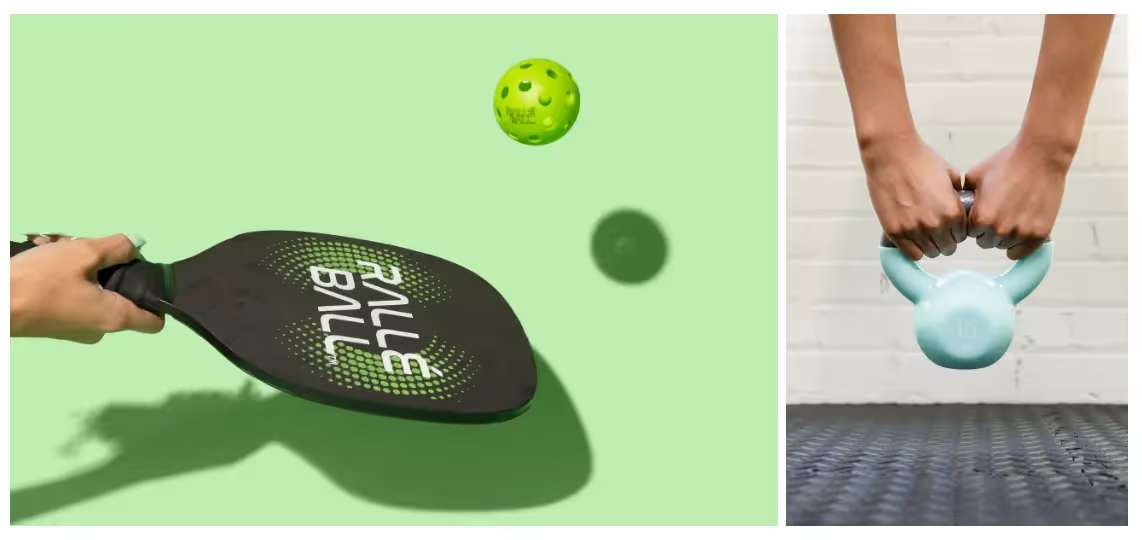
Home goods and furniture
Products like furniture, kitchen accessories, and other home goods are often designed to fit into a consumer’s daily life. Using a model can help illustrate the product’s functionality and how it will be used, encouraging customers to imagine themselves in similar scenarios.

For example, you might feature a model lounging on a sofa or cooking with a pan to show the product in a relatable, real-world context.

Beauty, cosmetics, and personal care items
Imagery is a core component to promoting your beauty and personal care products. When you photograph makeup, skincare, and haircare products need to show real-life application and effects on a person. A model helps demonstrate the product’s impact on different skin tones, hair types, or facial features.

Lipstick shades, foundation colors, and hair care tools are more appealing when potential buyers can visualize how they’ll look when applied to a person with similar characteristics. Beauty product photography featuring models is the key to doing so.

High-end or luxury items
Luxury goods like designer handbags, watches, or bespoke apparel benefit from aspirational marketing featuring people. Models help create a premium, lifestyle-driven brand image, positioning the product as something desirable.

For example, a model dressed in luxury garments or wearing a high-end watch can give the product a sense of exclusivity and allure.
Children’s products
For items like kids’ clothing, toys, or furniture, using child models helps convey the product’s use and appeal in a realistic way. It helps parents visualize the fit, usability, and age-appropriateness.

For example, you might feature child models playing with toys or wearing clothing to help parents see how the product fits or functions for kids of different ages and sizes.
Get started with model photography services from soona
If you’re ready to elevate your visual content with professional model photography, soona makes it easy to get started. With our seamless online booking system, you can hire models and book photoshoots in just a few clicks—no need to worry about long-term contracts or complicated logistics.
Simply subscribe to an ongoing plan or pay a one-time booking fee and enjoy lifetime access to your custom content, designed to enhance your product pages and social channels. We’ll handle the talent for you. 😉
Whether you’re launching new products or refreshing your current listings, soona model photography services can help you capture the high-quality, on-brand images your business needs to grow and succeed across all ecommerce channels.
Explore our model services here and check out our photo and video packs for full-body model shoots that can help your brand stand out.
Model ecommerce photography FAQs
Do you need a model release for photography?
Yes, you need a model release for photography if you’re using it for commercial purposes, including your website, product pages, social media, or any other promotional content. A model release is a legal document that grants you permission to use the model's likeness in your marketing materials. Without one, your business could face legal challenges if the model objects to how their image is used later on. When you work with models through soona, we handle all these logistics for you—so you can focus on content and not the legal hurdles.
Why are models used in photography?
Models play a critical role in ecommerce photography because they help bring your products to life. For a brand that places high value on content creation and brand perception, models allow potential customers to envision how products fit into their own lives. They add an aspirational element, show product functionality, and can evoke the lifestyle your brand represents. Additionally, models help create emotional connections with your audience, which can significantly influence purchase decisions and enhance brand loyalty. For a fast-growing brand consistently launching new products, using models can help build a recognizable, consistent image across multiple online channels.
Model photography brings something to the table that flat lays and mannequin shots just don’t seem to capture—life, jazz, movement. Sometimes that’s just what your product pages need to drive conversions.
But you can’t just use any old model photos—you gotta capture those high-quality gems. We’re not talking about hiring high-fashion models, but you’ll need to invest a little bit of time and effort into the process to set your shots up for success.
Understanding how to prepare for and nail your ecommerce model photography can feel a bit overwhelming. So, here’s the 411 on how you can use ecommerce on-model photography to drive sales for your online store.
Book a model in just a click! Only pay a one-time fee and use your content forever >
Why you need a model for ecommerce photography
Flat lays, mannequins, and models each have their moment. Knowing when to use each type of product photography is key to engaging your customers with stunning visuals and driving sales.
Mannequin and flat lay shots are effective when you want the products to speak for themselves on your ecommerce website. These two types of product photography minimize visual distractions and let your customers focus on the product.

But many times those images don’t tell the whole story. Leaving part of the product story out can mean falling flat when it comes to sales. Customers want to understand your product. What is its history? What does its journey look like? Flat lays and mannequin shots might leave out critical details that can influence customers to move past any barriers to purchase.
Sure, you can spice your flat lay up with some creative props. But nothing compares to lifestyle images created with model photography. They give your products an enviable quality. Customers can imagine themselves (and what their lives would be like) when they commit to the purchase.
Professional models know just how to showcase your products. Sometimes flat lays can look a little, well, flat. They lack dynamic movement. Don’t misunderstand, there’s a time and place for flat lays. But models can do that flowy garment more justice than a flat lay or mannequin can.
{{studio-ad}}
Types of models in product content
While you might think of the traditional high-fashion model when you think of “models,” there are actually plenty of creative ways to showcase people—and pets!—in your visual product content.

Full body
A full body model shot features all or most of the model in the content. This could be everything from their feet to the top of their head. Full body models increase your customers’ purchase confidence by showing a real person falling in love with your brand.

Full body models are required for:
- Showing a friendly face with your product
- Featuring body parts beyond the hand and forearm
- Consuming food or beverage products
- Wearing clothing, accessories, and shoes
- Video demonstration
Full body models start at $159/hour with soona >
Hand
Shots featuring hand models are—you guessed it—images that only show the person’s hand and perhaps wrist and arm as well. You can use hand models to demonstrate the size, scale, and features of your product. Hand models add life and movement—they’re always our first recommendation if you want to bring new energy into your content.

Common uses for hand models include:
- Unboxing videos
- Holding or moving a product on camera
- Action shots or product demonstrations
- Showing the application of product on hand or lower arm up to the elbow
- Wearing jewelry (rings, bracelets, etc.)
Hand models start at $79/hour with soona >
Foot
Foot models are common in shoe photography in particular, as they only feature the person’s feet. They help you capture attention at every step! Foot models show customers how they can rock your product by bringing it to life.

Common uses for foot models include:
- Providing human shape to socks, shoes, braces, or other footwear
- Demonstrating foot and leg care product application or functionality
- Pose variety and movement
- Showcasing pedicure or nail art
- Video demos with the knee, lower leg, or feet
Foot models start at $99/hour with soona >
Pet
Make your customers swoon with an adorable pet model. Pet models are handy for showcasing pet products—food, treats, accessories, and even clothing—but they can also be effective in other contexts. For example, if you sell a couch that’s stain-resistant or want to promote a household cleaning product that can handle pet stains.

Here are some more ideas on when you might use a pet model:
- A pet posing in any setting with any product types
- A pet playing or eating on camera
- Showcasing the fit of pet clothes, shoes, or accessories
- A pet interaction in lifestyle settings
Pet models start at $99/hour when you work with soona >
When do you need a model for ecommerce photography?
So, when do you need to use “on model photography” for your photoshoot? Let’s take a look:
Clothing and apparel
If you’re in the apparel or fashion industry, models are a must.
Shoppers need to see how clothing or accessories fit on a real person before they feel confident making a purchase, especially online. The right model helps showcase how a garment drapes, fits, and moves with the body—this is difficult to convey through flat product images. Using people allows you to communicate context for size, fit, and style, increasing consumer confidence in purchasing.

Models essentially take the place of the fitting room for online shoppers.

Fashion apparel photography in particular often uses models to align the product with current trends and lifestyle aspirations. Fashion models create a lifestyle vibe that can really drive your customers wild.
Trendy fashion apparel or accessories targeted toward stylish buyers need models to demonstrate how they look in the latest designs, conveying personality, mood, and trend relevance.

Outerwear and seasonal clothing like coats, jackets, and scarves should also be shown in context to communicate warmth, style, and functionality. A model helps demonstrate how such items look when worn in a real environment, especially for cold-weather gear.

For example, a model wearing a winter jacket or scarf in an outdoor scene adds authenticity and appeal, showing how it fits into a particular season or climate.
Jewelry and accessories
Also in the fashion industry, jewelry and other accessories are best displayed on a human body, as they often interact with the shape and movement of the wearer. A model can show how a necklace falls, how earrings frame the face, or how a handbag looks when carried.

Rings, watches, and bracelets all benefit from being worn by a model to highlight the product’s size, sparkle, and real-life scale.

Footwear
Footwear photography also benefits from the use of foot models. Shoes, boots, and sandals need to be shown in the context of wear to display their fit, style, and overall aesthetic. A model helps demonstrate how the shoes look when being worn, how they match various outfits, and how comfortable or practical they appear in use.

High heels, sneakers, or boots shown on a model can convey fit and style more effectively than standalone product images.
For example, footwear brand Gales worked with soona to create product content that features both on-model photography and product shots without humans. The content mix has enabled it to create a distinct visual brand aesthetic with a variety of shots that engage users across various channels, like email campaigns, blogs, social media, and its online stores.

Athletic and sports products
For products like gym equipment or athletic gear, customers want to see how the items perform under action and movement. A model can illustrate the flexibility, durability, and performance of activewear or sporting goods.

You might feature a model doing yoga or running in fitness leggings or using sports equipment like tennis rackets or golf clubs to make the product more relatable and appealing.

Home goods and furniture
Products like furniture, kitchen accessories, and other home goods are often designed to fit into a consumer’s daily life. Using a model can help illustrate the product’s functionality and how it will be used, encouraging customers to imagine themselves in similar scenarios.

For example, you might feature a model lounging on a sofa or cooking with a pan to show the product in a relatable, real-world context.

Beauty, cosmetics, and personal care items
Imagery is a core component to promoting your beauty and personal care products. When you photograph makeup, skincare, and haircare products need to show real-life application and effects on a person. A model helps demonstrate the product’s impact on different skin tones, hair types, or facial features.

Lipstick shades, foundation colors, and hair care tools are more appealing when potential buyers can visualize how they’ll look when applied to a person with similar characteristics. Beauty product photography featuring models is the key to doing so.

High-end or luxury items
Luxury goods like designer handbags, watches, or bespoke apparel benefit from aspirational marketing featuring people. Models help create a premium, lifestyle-driven brand image, positioning the product as something desirable.

For example, a model dressed in luxury garments or wearing a high-end watch can give the product a sense of exclusivity and allure.
Children’s products
For items like kids’ clothing, toys, or furniture, using child models helps convey the product’s use and appeal in a realistic way. It helps parents visualize the fit, usability, and age-appropriateness.

For example, you might feature child models playing with toys or wearing clothing to help parents see how the product fits or functions for kids of different ages and sizes.
Get started with model photography services from soona
If you’re ready to elevate your visual content with professional model photography, soona makes it easy to get started. With our seamless online booking system, you can hire models and book photoshoots in just a few clicks—no need to worry about long-term contracts or complicated logistics.
Simply subscribe to an ongoing plan or pay a one-time booking fee and enjoy lifetime access to your custom content, designed to enhance your product pages and social channels. We’ll handle the talent for you. 😉
Whether you’re launching new products or refreshing your current listings, soona model photography services can help you capture the high-quality, on-brand images your business needs to grow and succeed across all ecommerce channels.
Explore our model services here and check out our photo and video packs for full-body model shoots that can help your brand stand out.
Model ecommerce photography FAQs
Do you need a model release for photography?
Yes, you need a model release for photography if you’re using it for commercial purposes, including your website, product pages, social media, or any other promotional content. A model release is a legal document that grants you permission to use the model's likeness in your marketing materials. Without one, your business could face legal challenges if the model objects to how their image is used later on. When you work with models through soona, we handle all these logistics for you—so you can focus on content and not the legal hurdles.
Why are models used in photography?
Models play a critical role in ecommerce photography because they help bring your products to life. For a brand that places high value on content creation and brand perception, models allow potential customers to envision how products fit into their own lives. They add an aspirational element, show product functionality, and can evoke the lifestyle your brand represents. Additionally, models help create emotional connections with your audience, which can significantly influence purchase decisions and enhance brand loyalty. For a fast-growing brand consistently launching new products, using models can help build a recognizable, consistent image across multiple online channels.



